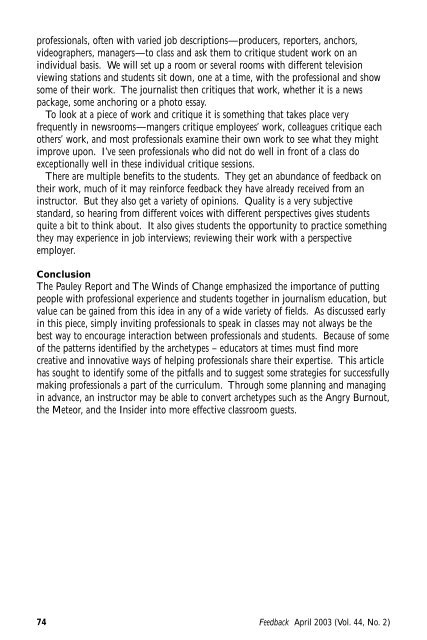APRILFeedback
Feedback April 2003 (Vol. 44, No. 2) - Broadcast Education ...
Feedback April 2003 (Vol. 44, No. 2) - Broadcast Education ...
- No tags were found...
You also want an ePaper? Increase the reach of your titles
YUMPU automatically turns print PDFs into web optimized ePapers that Google loves.
professionals, often with varied job descriptions—producers, reporters, anchors,videographers, managers—to class and ask them to critique student work on anindividual basis. We will set up a room or several rooms with different televisionviewing stations and students sit down, one at a time, with the professional and showsome of their work. The journalist then critiques that work, whether it is a newspackage, some anchoring or a photo essay.To look at a piece of work and critique it is something that takes place veryfrequently in newsrooms—mangers critique employees’ work, colleagues critique eachothers’ work, and most professionals examine their own work to see what they mightimprove upon. I’ve seen professionals who did not do well in front of a class doexceptionally well in these individual critique sessions.There are multiple benefits to the students. They get an abundance of feedback ontheir work, much of it may reinforce feedback they have already received from aninstructor. But they also get a variety of opinions. Quality is a very subjectivestandard, so hearing from different voices with different perspectives gives studentsquite a bit to think about. It also gives students the opportunity to practice somethingthey may experience in job interviews; reviewing their work with a perspectiveemployer.ConclusionThe Pauley Report and The Winds of Change emphasized the importance of puttingpeople with professional experience and students together in journalism education, butvalue can be gained from this idea in any of a wide variety of fields. As discussed earlyin this piece, simply inviting professionals to speak in classes may not always be thebest way to encourage interaction between professionals and students. Because of someof the patterns identified by the archetypes – educators at times must find morecreative and innovative ways of helping professionals share their expertise. This articlehas sought to identify some of the pitfalls and to suggest some strategies for successfullymaking professionals a part of the curriculum. Through some planning and managingin advance, an instructor may be able to convert archetypes such as the Angry Burnout,the Meteor, and the Insider into more effective classroom guests.74Feedback April 2003 (Vol. 44, No. 2)
















